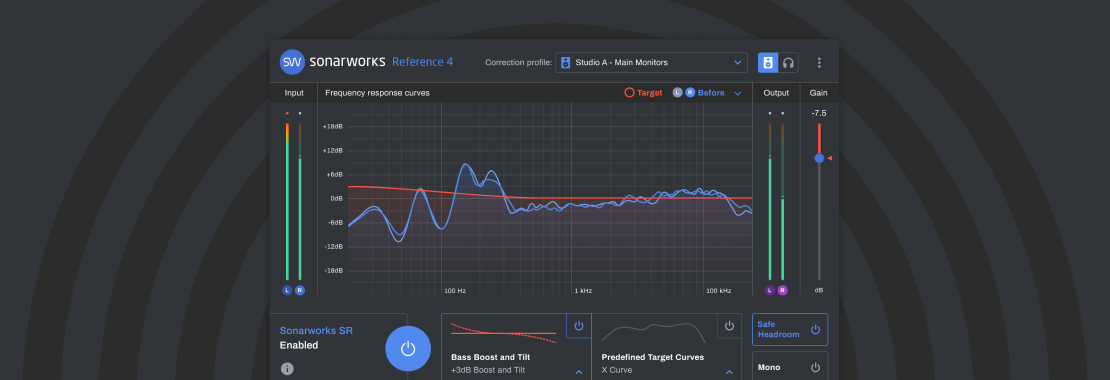

- #Sonarworks reference 3 update release notes how to#
- #Sonarworks reference 3 update release notes download#
- #Sonarworks reference 3 update release notes windows#
Yes, absolutely! CanOpener Studio works well in conjunction with Sonarworks Reference, and they are both linear processors that should not introduce distortion or other unwanted nonlinearities.Īlthough we recommend putting CanOpener last in the monitoring chain, it generally doesn’t matter which order you place them in (except when you use CanOpener’s dither feature, in which case you must place CanOpener last). You might be wondering: Why doesn’t the processing order matter that much? The answer: CanOpener is a linear processor - it’s the same reason why 2 + 3 = 5 and 3 + 2 = 5.)Ĭan I use CanOpener Studio with Sonarworks Reference? If so, in which order should I place them in the chain? If you are using a headphone EQ correction plugin that uses different profiles for the left & right channel, CanOpener should be placed in front of it. If you’re not using CanOpener’s built-in dither, the processing order matters less, but CanOpener should still be near the end. Ideally, CanOpener would be placed last in the processing chain on the master channel. What order should CanOpener be placed in the processing chain? It’s less true-to-life but can be useful in situations where realism is less important. If you want the flattest possible frequency response, setting the Crossfeed Angle to 0º will achieve that (see the Mix Engineer, Flat preset). It’s quite lifelike and perceptually matches a real-world set of studio monitors very closely.ġ50% crossfeed is technically more lifelike (see the Mix Engineer, Lifelike preset), but it can sound overly narrow on some headphones. Rather than emulate a specific studio control room or loudspeaker setup (along with all its flaws), the CanOpener crossfeed algorithm uses an idealized loudspeaker & room as its guide and gives you the control to use as much or as little of it as you need.īreaking down the details Some CanOpener Studio FAQsĬrossfeed 100%, 60º is a great place to start (the Mix Engineer preset). Crossfeed - Less is moreĬanOpener Studio takes a less-is-more approach: fix the bad things about headphones with as little coloration or alteration as possible. Similarly, headphones often have irregular, exaggerated, or unnatural frequency response curves, either because they were designed that way or because they lack the natural bass reinforcement that would occur in a real room with speakers. mono sounds typically appear to originate from inside the listener’s head as opposed to externally). Headphones also offer poor externalization (i.e. Compared to speakers, music often sounds overly “wide” when listened to on headphones, as if there were a section missing from the center of the stereo image. The main “problem” with headphones is that most music is still created (recorded, mixed, mastered) on speakers, with tools that were primarily designed for loudspeaker playback. In reality, though, these conditions are rarely met, and headphones often end up sounding unnatural, uninspiring, and fatiguing when listened to for long periods of time.

Under the right conditions, headphones can be excellent, high-fidelity monitoring tools.
#Sonarworks reference 3 update release notes windows#
Into the Windows Explorer address bar and press Enter key:Īfter deleting the Systemwide folder, relaunch SoundID Reference and verify if SoundID Reference is working as intended.“CanOpener conjures speakers from your headphones.” Hidden folders like AppData can be made visible by checking the Hidden Items box in the Windows Explorer View tab:Īlternatively, you can type in %localappdata%/sonarworks/SoundID Reference Windows C:\Users\Username\AppData\Local\Sonarworks\SoundID Reference ~/Library/Sonarworks/SoundID Reference/Systemwide
#Sonarworks reference 3 update release notes how to#
The instructions on how to blacklist the drivers can be found here. Please quit SoundID Reference from the tray icon, and create a blacklist file. IMPORTANT! If you have updated to the latest SoundID Reference version 5.1.0.72 (released Sep 28) and the SoundID Reference app is no longer launching, this may be connected to the ASIO drivers installed on your computer.
#Sonarworks reference 3 update release notes download#
Resolution version: 5.1.1.64 - Download here


 0 kommentar(er)
0 kommentar(er)
